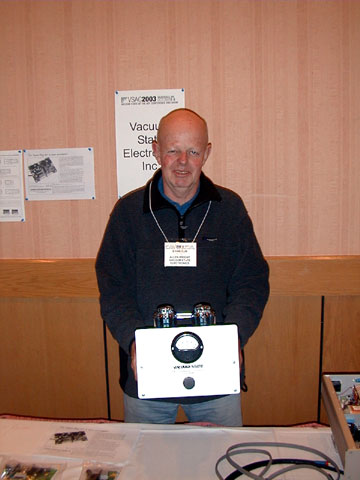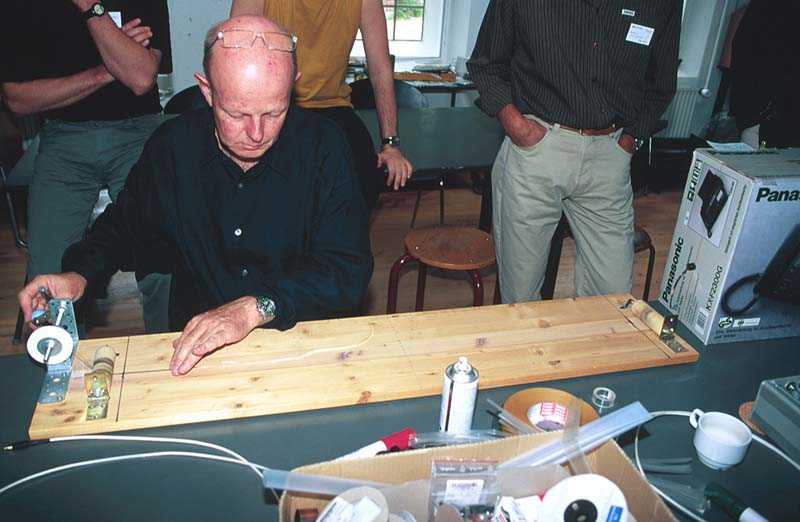- These many development steps are described in much greater detail in the Vacuum State 'TubePreamp CookBook' which has now sold some 2000 copies to tube equipment enthusiasts worldwide! The SVP-2 is an evolution of Allen Wright's FVP5A single ended preamp design, which has been under development in various forms for over 25 years.
- Allen Wright, known for his The SuperCables CookBook and The Tube Preamp CookBook also offers a differential tube power supply amplifier DPA-300B monoblock. Under his Vacuum State brand name, this unit has a pair VV32B output tubes and Sovtek tubes. Construction is 100% point-to-point hand wired while trannys are by Lundahl.
- The Tube Preamp Cookbook Allen Wright Model
- The Tube Preamp Cookbook Allen Wright -
- The Tube Preamp Cookbook Allen Wright Iii
- The Tube Preamp Cookbook Allen Wright Books
The Tube Preamp Cookbook Allen Wright. (which I think is a must if you want to get full benefit from this preamp), I ordered it as a kit from Allen - it's cheap.
The Tube Preamp Cookbook - Allen Wright
Product: The Tube Preamp Cookbook
Manufacturer: Vacuum State Electronics - Allen Wright
Approximate price: US$40 (internet sales only)
Reviewer: Werner Ogiers
Reviewed: May 2001
As you may know already I feel that a pre-amplifier can be a system's most critical part. And this not only in a turntable system, but even in a digital-only context, where one would be let to believe that a CD player's 2V output simply obviates the need for a preamp.
As such I always have been fascinated with pre-amplifiers, and of lately I have been so with the few big and serious valve phono preamps that are around: the Arthur Loesch; our own Thorsten's interpretation of it, the Toccata; and Allen Wright/Vacuum State Electronics' FVP and RTP series. What all of these have in common is that they are essentially DIY components, not even always commercially available, but most certainly always of a non-compromising nature.
Recently the Vacuum State (VSE) single-ended FVP5 and balanced RTP preamps have been made available readily-built (and still as kits, of course), which prompted me to poll Allen Wright for a review of the FVP. No demo sample could be sent at short notice, though it still may happen that both Geoff and me get our hands on an early and reworked prototype FVP5 later this year, also sprach Allen. In the meanwhile, why not read and review a couple of VSE's audio cookbooks?
And so I got a Tube Preamp Cookbook (obviously) and a Cable Cookbook (slightly less obvious for those who know me).
The Tube Preamp Cookbook Allen Wright Model

Behold the word
Any fussy mainstream-high-end casualty (you know, the ones with wooden dots on their walls and luxury wooden cable boxes in their luxury wooden closets, a $1000 laser system setup tool and a score of burn-in CDs) would immediately condemn the Cookbook as way overpriced.Indeed, the TPCB is a low-key, low-budget publication (probably the only way to actually have it published at all), made with what seems to be a 1987 word processor and printer, most of the schematics hand-drawn, and enough inconsistency in the layout to be charming. Less charming is the horizontal A4 format: I tend to read my books in bed...
But as JRRT already so rightfully pointed out: all that is gold does not glitter.
And damn the right-wing high-enders. Just as it is about the music, and not about the sound (well...), it is also about the words, and not about the paper they're printed upon.
More than a technical and dry volume on the basics of thermo-ionic valves and amplifiers made thereof, the TPCB reports on a decades-long journey made by a self-proclaimed loony in search of audio components with the so elusive quality of leaving the music intact. This means that it isn't an introductory course to tube amps. Rather, if you know how to calculate your gain stages, how to make things stable, and other indispensable basic recipes of the cuisine, then the book suggests ways of making things sound good too. At least, in Allen's opinion.
OK then, read it!
The Tube Preamp Cookbook Allen Wright -
Wright starts out by defining the goal: the reproduction of music by a system harmless to it by virtue of a wide bandwidth and a wide 'Downward Dynamic Range' (DDR, is that why Thorsten got so involved in this valve stuff?). The goal is split into a number of elementary criteria the system has to fulfil, and then we are given a overview of the building blocks to our disposal to build such a system with: passive components ('trash those styroflexes!'), cable ('must be thin solid core'), valves (how to distinguish real Telefunkens from post-seventies east-german tubies with the same name), decent pot, connectors, audio magazines (!), transformers, ... Each of these reviewed with an underlying philosophy of purity, of low distortion, and of signal integrity, and put into the context of the extremely wide - in all respects - nature of the music signal, and of human perception: there are anecdotes of near-magical perceptional experiences, not all of them audio-related. These are amusing at the least, and often fascinating.
On it goes then, with a review of active and passive circuit configurations for preamplifiers: ordinary stuff such as common cathode stages, cascoding, RIAA-equalizers-done-wright, Miss Piggy, ... but also less often seen things ripped out of old HP and Tektronix scope frontends, and Wright's solution for driving real loads: the 'Super Cathode Follower'. These circuits are nothing without sound nutrition, so the next chapter makes choke-filtered power supplies mandatory, and continues with an advanced solid state high (and low) voltage shunt regulator, the 'SuperReg'. All of these concepts are not only listed with their schematics and their development histories, but also, and more importantly, with a lot of humour, and with their sonic properties as perceived by Allen Wright.

The reader having now established a knowledge of what might sound good and what might not, Wright then comes to the salient portions of the book (well, salient is relative, given the tons of useful information in the introductory chapters): a checklist for those who want modify existing preamps, and the tale of his two brainchilds, the FVP and RTP preamps. Both these are over-the-top designs, built from current-source driven cascoded gain blocks, in configurations that attempt to go from (MC) input to (line) output in as little as possible stages.
The FVP originally started out in the seventies as a politically correct (and uninspired?) modification of Quad 22 or Dynaco PAS-3 style circuitry. Over the years Allen Wright pushed its performance, once or twice completely turning the amp's concepts upside down, to arrive finally at a five triode MC-capable pre-amplifier that most probably has to be counted among the Great Ones.
But then there's of course the Greater One: the RTP, or Real Time Preamp. This is a much more complex fully-balanced design (yeah, born from those Tek and HP scopes), evolved over four generations into the 1997 RTP4 hybrid FET-valve monster that does the trick (MC-to-pre-out) in two gain stages only! Wow.
Concluding
What's the value of a lovingly-made, yet also amateurish, book in the days of the WWW, when a simple search yields plenty of information and schematics on quality valve amplification? What's the value of such a book when the author's own website publishes the latest schematics and updates to the very same preamplifiers that are described in the book?
What can I say? In the past year I've scrolled through almost anything on (pre)amplifier design that can be found on the web. And yet, I read 70% of the Tube Preamp Cookbook in the hours right after receiving it. This went on deep into the night, and after suffering some insomnia (guess why) I got up and read some more. The TPCB is entertaining, witty, informative, and above all, thought-provoking and inspiring, even if you don't plan on designing or building your own (or Allen's) tube preamp. The book helps all of us actively doing anything in audio focusing our minds on the task at hand. In my own case I started questioning a few decisions I had made for the design of my FET preamp: this alone well worth the asking price for the TPCB.
Without the Tube Preamp Cookbook I would regard my personal library incomplete.
© Copyright 2001 Werner Ogiers forTNT Audio Magazine (https://www.tnt-audio.com)
Vacuum State Of The ArtConference And Show 2003 (VSAC)
Sunday Part 2
The Tube Preamp Cookbook Allen Wright Iii
Anita was proudly showing the Vacuum Tube Valley (VTV) magazine and a wide range of T-shirt, bumper sticker, back issues and more.
Charlie Kitteson of VTV was offering rare books, NOS tubes, tube tester, and other goodies.
Tube Research Labs had their six-channel, three input tube surround sound pre-amplifier. This 160 lbs. unit has eleven tubes all operating in 'Class A' with tube power supply/rectification.

Allen Wright, known for his The SuperCables CookBook and The Tube Preamp CookBook also offers a differential tube power supply amplifier DPA-300B monoblock. Under his Vacuum State brand name, this unit has a pair VV32B output tubes and Sovtek tubes. Construction is 100% point-to-point hand wired while trannys are by Lundahl.
Experience Music's Lowther equipped Exhilaration had the DX-4 driver in large horn plus the Sheerin bass horn with Lambda TD-1 Specials. Experience Music's Surrender 2A3 single-ended triode monoblocks powered the Lowthers while a solid-state amplifier juiced the Sheerin bass unit.
Redpoint had their Excess turntable has a lead shot and oil dampened base and completely isolated arm and motor assembly. The platter employs a 2-inch thick piece of Teflon.
The Tube Preamp Cookbook Allen Wright Books
Redpoint also has their Testarossa turntable that as a solid aluminum base with special 1-inch thick Teflon platter. A perfect mate for those with a wonderful 12 cylinder wondercar from Maranello :-)
It is a sign of the times when you are a Bottlehead. Good ol' Doc B had a large room playing master tapes and vinyl (plus the odd digital discs) with the Progressive Engineering turntable serving analog duties. Doc B yummies included his Seduction phono stage, Two-Way pre-amplifier, and Paradox TJ 2A3 tube monoblock amplifiers (seen below). The loudspeakers are a prototype of the Climax.
Bent Audio prototype Flat loudspeaker uses a pair of Furuyama flat drivers from Japan mated with Aurm ribbon tweeter.
Bent Audio offers many other products including their MU step-up transformer that is offered in both copper and silver wired.
Audist Loudspeakers had their prototype of the Concerto 1 that employs a constant directivity waveguide on the Raven 1 ribbon tweeter and PHL 2460 midrange/woofer driver. This front-ported design has a 2-inch thick solid Poplar wood baffle.